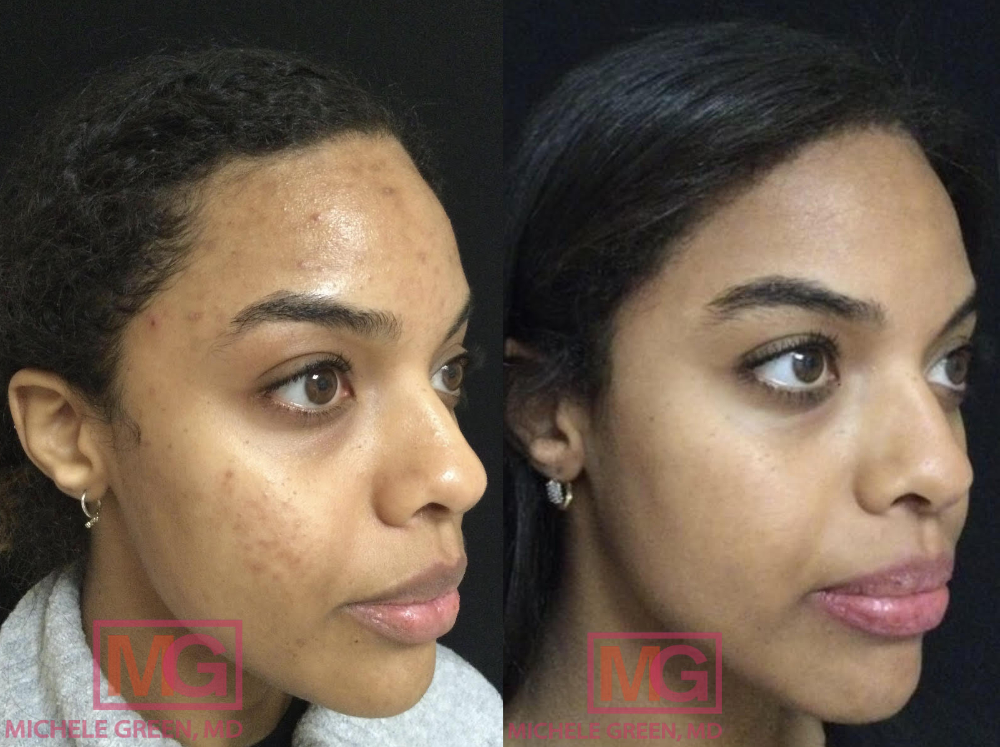Hormonal Acne Treatment
Many people assume that acne breakouts will disappear after their teenage years. Unfortunately, many adults struggle with persistent acne for years after puberty. Hormonal acne is a specific type of adult acne that can occur in both men and women; however, it is most prevalent among women aged 20 to 40. Women experiencing hormonal acne breakouts often notice cystic pimples along the jawline, chin, and cheeks, appearing in a cyclical breakout pattern. Hormonal acne breakouts may be linked to various changes, including alterations or discontinuation of birth control, menstruation, menopause, or pregnancy. Breakouts of hormonal acne may unexpectedly arise after years of completely clear skin and can be both frustrating and challenging to treat. Fortunately, board-certified dermatologist Dr. Michele Green in NYC is available to help.
Hormonal acne breakouts are often triggered by the production of excess androgens, or male hormones, in the body, resulting in increased sebum production and clogged pores. Treating hormonal acne can be particularly challenging, as these breakouts often do not respond well to traditional acne treatments like oral antibiotics and topical skincare products. The first step in addressing hormonal acne is to consult with an experienced, board-certified dermatologist, such as Dr. Green, who will gather a complete medical history and assess the acne before devising a customized treatment plan. While this type of acne flare-up can be frustrating for many, Dr. Green utilizes a variety of oral medications, topical creams, in-office treatments, and skincare products in her patients’ treatment plans to effectively manage and eliminate hormonal acne for clear, radiant skin.
Dr. Michele Green is a world-renowned, board-certified dermatologist with over 25 years of experience in both medical and cosmetic dermatology, including hormonal acne treatment and acne scar reduction. She is consistently recognized as one of New York’s best dermatologists by Castle Connolly, New York Magazine, Super Doctors, and the New York Times for her dedication to her patients and her expertise. Dr. Green takes pride in building relationships with her patients, dedicating the necessary time to understand each individual’s specific skin concerns and customizing their treatment accordingly to address the unique needs and goals of every patient. She developed her skincare line, MGSKINLABs, to treat a variety of skin conditions, from acne breakouts to the different signs of aging. When you consult with Dr. Green, she collaborates with you to create a tailored hormonal acne treatment plan suited to the type and severity of your hormonal acne, helping you achieve and maintain clear, healthy, smooth skin.
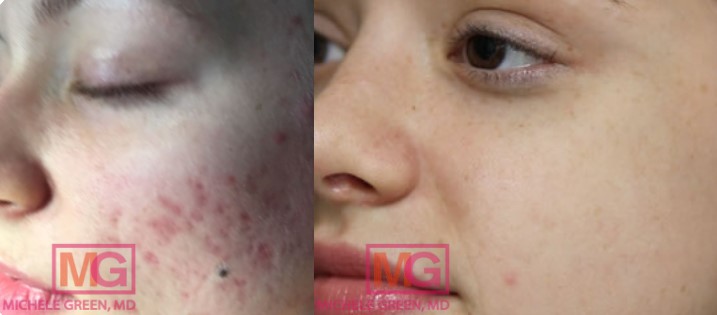
25-34 year old woman treated with acne scar treatment
What is hormonal acne?
Hormonal acne refers to breakouts caused by the overproduction of sebum from the skin’s sebaceous glands. Androgen sex hormones, crucial for growth and reproduction, can also contribute to acne. When levels of androgen hormones rise, they stimulate the skin to produce more sebum. This excess oil clogs pores with acne-causing bacteria, leading to pimples, painful cysts, and comedones (commonly known as blackheads and whiteheads). While acne most frequently occurs during puberty, it can also affect adults, typically between the ages of 20 and 40. Acne flare-ups in adulthood are usually attributed to hormonal acne. Both men and women can experience it; however, women are significantly more likely to suffer from hormonal acne breakouts during adulthood.
What flares up hormonal acne?
As the name suggests, As the name suggests, hormonal acne is triggered by fluctuations in hormone levels, particularly testosterone, estrogen, and progesterone, which leads to increased oil production in the skin’s sebaceous glands. Hormonal acne breakouts, also known as adult acne, can occur in both men and women between the ages of 20 and 50. Endocrine disorders, such as hypothyroidism, can also cause hormonal acne breakouts during adolescence and adulthood. Hormonal acne is more common in adult females than in adult males due to various factors, including hormonal fluctuations during menstrual cycles, pregnancy, menopause, and polycystic ovary syndrome (PCOS). Many women experience hormonal acne breakouts in the week before or during their menstrual cycle. Progesterone levels rise in the second half of the menstrual cycle, potentially stimulating excess oil production in the skin and causing the pores to swell shut, which traps excess sebum, dead skin cells, and other debris. During menopause, many women experience hormonal acne due to changes in hormone levels. Menopause is typically marked by a decrease in estrogen and an increase in androgen hormones like testosterone, which can lead to more acne blemishes. With PCOS, elevated androgen hormones such as testosterone result in increased oil production, clogged pores, and acne formation.
How do you know it’s How can you identify hormonal acne?
A few key characteristics identify hormonal acne breakouts. Acne during adulthood is often hormonal. Furthermore, acne that flares in a cyclical pattern and worsens monthly is typically hormonal. Many women with hormonal acne report flares during their period or just before it. Increased stress can significantly influence hormonal acne breakouts. Acne that arises during events such as menstruation, pregnancy, and menopause, as well as after starting certain oral medications or due to medical conditions that cause hormonal changes, suggests hormonal acne. During puberty, acne usually appears in the T-zone; however, in adults, hormonal acne commonly appears along the jawline and lower face. Consulting an expert, such as board-certified dermatologist Dr. Michele Green, ensures proper diagnosis and treatment of adult acne. In addition to physically evaluating your skin condition, Dr. Green will collect a thorough medical history and may order specific blood tests to assess irregular hormone levels.
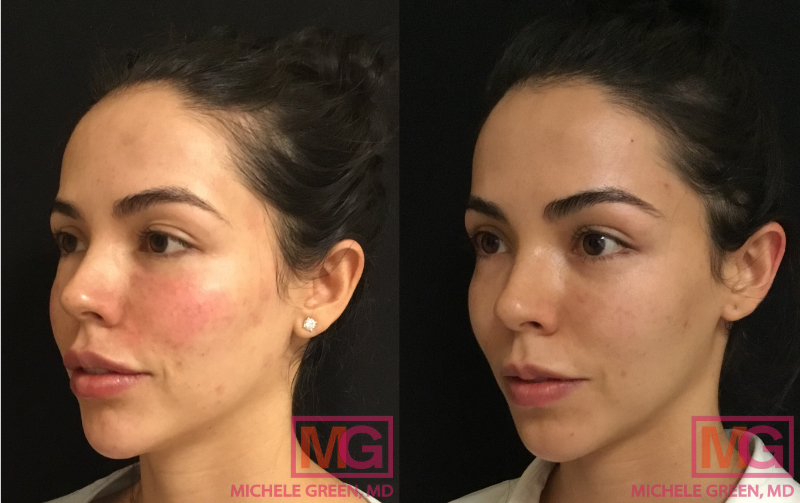
Vbeam, 2 months before and after
How does a dermatologist treat hormonal and cystic acne?
It is always advisable to consult a board-certified dermatologist about acne vulgaris breakouts, especially if they are persistent, recurring, or cystic. This is because acne, particularly inflammatory types like cysts, can lead to permanent scarring. Acne scars develop due to inflammation associated with lesions, causing irreparable damage to the underlying skin tissue. While cosmetic procedures can improve the appearance of acne scars, the most effective treatment is preventing the breakouts themselves. A dermatologist, such as Dr. Green, can evaluate the patterns of breakouts, their severity, and the types of acne present during a physical examination. Additionally, other contributing factors will be discussed, including skincare routines, family history of acne, lifestyle habits, and other underlying health conditions. Dr. Green may also order blood tests to determine whether an imbalance in certain hormone levels contributes to the breakouts. Subsequently, Dr. Green will collaborate with you to create a personalized treatment plan using in-office procedures, prescription medications, targeted skincare products, or a combination of treatments to help you achieve and maintain healthy, smooth skin.
How to get rid of hormonal acne?
The first step in regulating your hormones and preventing acne The first step in regulating your hormones and preventing acne breakouts is to consult a board-certified dermatologist, like Dr. Michele Green in NYC. She has the expertise and experience necessary to identify the underlying causes of breakouts and treat them effectively. During your visit to Dr. Green’s private dermatology office on the Upper East Side of Manhattan, you will discuss your medical history, lifestyle, skincare routine, and more. She may order lab tests to uncover any underlying medical conditions, as hormonal acne can indicate a more serious issue, such as hormonal imbalance or a thyroid condition. Alongside oral medications that balance hormone levels, she recommends topical treatments, in-office procedures, and non-comedogenic skincare for patients dealing with hormonal acne and acne-prone skin. In your consultation, Dr. Green will customize a treatment plan that meets your skin needs and goals.
In-office procedures
Various in-office treatments can enhance the appearance of hormonal acne. These procedures help eliminate debris clogging the pores, resulting in smooth, acne-free skin.
- Acne surgery: Acne surgery is a traditional method for removing specific acne breakouts and cysts. It involves opening clogged pores to extract dead skin cells, excess oil, debris, and other impurities trapped within the acne lesions. After the lesions are opened, cortisone is injected to reduce inflammation, speed healing, and prevent the formation of acne scars. Acne surgery is most effective when combined with prescription antibiotics to decrease bacteria that cause acne. It is particularly effective for treating cystic acne on the chest, as it helps prevent lesions from leading to scarring. If the cysts are very large, they may require drainage before injecting cortisone into the affected area.e
- Hydrafacial: The HydraFacial is a medical-grade hydradermabrasion treatment that gently cleanses, exfoliates, and nourishes the skin. This procedure uses proprietary vortex technology, which is excellent for removing sebum, dead skin cells, and debris trapped in the pores that can lead to acne. The first step involves cleansing the skin and applying a chemical peel containing glycolic and salicylic acid to soften the debris. Next, the buildup and debris lodged in the pores are extracted, and the skin is exfoliated. After cleansing and exfoliating, antioxidants, vitamins, and peptides are infused into the skin to enhance its natural protective barrier. A HydraFacial can also be enhanced with specially formulated boosters, which are applied after cleansing and exfoliating to deliver targeted active ingredients. The infusion of a booster serum can help address various skin conditions, including acne, redness, dullness, and aging skin.
Oral prescription medications
Various prescription medications can reduce and prevent hormonal acne. These oral medications vary in composition, but they all excel at controlling acne breakouts and preventing further hormonal acne from developing.
- Birth control pills: One of the most common approaches to treating One common approach to treating hormonal acne in adult women is using birth control to regulate hormone levels. Oral contraceptive pills are often utilized to adjust hormone levels that may otherwise trigger an acne breakout, with brands like Ortho Tri-Cyclen, Estrostep, and YAZ being FDA-approved for treating hormonal acne in female patients. Effective oral contraceptives for hormonal acne typically include a combination of progestin (such as drospirenone) and estrogen (such as estradiol). However, oral contraceptives may not be suitable for acne treatment if you have a history of blood clots, high blood pressure, breast cancer, or if you smoke tobacco.
- Spironolactone: Spironolactone is a widely used medication that can help adult women experiencing hormonal acne breakouts. Although it is primarily prescribed as a diuretic for managing blood pressure, Spironolactone also works to regulate androgen levels, thus reducing excess oil production and the accumulation of dead skin cells that often block pores. Oral Spironolactone is a treatment option intended for non-pregnant female patients, as it may lower testosterone levels in males and lead to undesirable side effects. This medication is particularly effective for patients with polycystic ovary syndrome, commonly known as PCOS.
- Hormone replacement therapy (HRT): Adult women experiencing hormonal acne due to menopause can find relief through HRT. Menopause involves a decline in hormones like progesterone and estrogen, along with an increase in androgen hormones such as testosterone, which can lead to excess oil production and acne blemishes. Hormone replacement therapy for menopause is available in various forms, including pills, gels, patches, and creams.
- Isotretinoin: Isotretinoin, commonly known by the brand name Accutane, is an oral vitamin A derivative that treats acne by reducing the size of sebaceous glands and decreasing oil production. Previously used only for severe acne or as a last resort, Accutane is now prescribed for all types of persistent, moderate acne as well. Isotretinoin is contraindicated for pregnant individuals and those actively trying to conceive, as it can increase the risk of birth defects; however, it does not affect a person’s ability to conceive in the future. Patients on isotretinoin must have monthly blood tests and follow-up appointments with their dermatologists, typically requiring at least a five-month course to achieve long-lasting clear skin. Female patients are required to undergo monthly pregnancy tests during isotretinoin treatment because one potential side effect of this medication is life-threatening birth defects. Patients taking isotretinoin should avoid alcohol consumption and limit supplementary whey protein intake, as the medication is processed through the liver. Additionally, isotretinoin can cause increased photosensitivity, so patients should limit sun exposure to protect their skin.
Topical prescription medications
While patients with cystic While patients with cystic hormonal acne often need oral medications for management, many individuals with hormonal acne benefit from topical treatments that reduce inflammation and prevent lesions. Dr. Green frequently recommends incorporating a topical medication into a targeted skincare regimen, alongside other treatment options, to diminish breakouts and avoid acne scars.
- Topical antibiotics: Topical antibiotics such as Clindamycin and Erythromycin are often prescribed alongside oral medications to treat acne breakouts. These treatments work by eliminating acne-causing bacteria on the skin. Benzaclin and Benzamycin are variations of these creams, formulated with Benzoyl peroxide to further reduce acne-causing bacteria and inflammation.
- Winlevi: Winlevi is a prescription topical treatment for hormonal acne that contains clascoterone, an anti-androgen medication. It works by inhibiting androgen activity in the sebaceous follicles, thereby preventing these hormones from producing excess sebum in the skin. By reducing oil production in the glands, Winlevi helps to prevent hormonal acne breakouts.
- Topical Spironolactone: Recent clinical studies have demonstrated that topical Spironolactone effectively reduces pimples without significant side effects and is safe to use in conjunction with other acne treatments. While oral Spironolactone serves as a hormonal acne treatment option specifically for women, topical Spironolactone effectively manages hormonal acne in both men and women, as there are no systemic side effects linked to the topical formulation.
- Retin-A: Also known as tretinoin, Retin-A is a prescription-strength retinoid derived from vitamin A. Retin-A enhances acne treatment by increasing the cell turnover rate, removing dead skin cells, and reducing clogged pores to reveal healthier, acne-free skin beneath. For individuals with sensitive skin or rosacea, topical retinoids may not be the ideal solution, as these creams and gels can cause dryness, redness, and flakiness when first used. Dr. Green may suggest applying your topical retinoid only a few times a week to avoid irritation or other mild side effects. If retinoids continue to cause irritation, an over-the-counter retinol can be used as an alternative, which penetrates less deeply but is gentler on the skin.
Skincare products
Patients with acne-prone skin and hormonal acne can benefit from a suitable skincare routine that incorporates targeted, acne-fighting ingredients. Internationally renowned and board-certified dermatologist Dr. Michele Green has developed a line of topical skincare products that are highly effective in treating acne blemishes. The Acne Kit from MGSKINLABs features a three-step system designed to clear the skin and reduce the appearance of pores. The Pore Minimizing Cleanser contains glycolic and salicylic acid, making it ideal for combating acne. Alpha and beta hydroxy acids, known as AHAs and BHAs, such as glycolic and salicylic acid, act as chemical exfoliants that soften debris clogged in the pores and gently extract it. AHAs and BHAs also promote skin cell turnover, minimizing dead skin cells that linger on the epidermis. The Retexturizing Pads, which also contain glycolic and salicylic acids, provide at-home peel benefits by exfoliating dead skin cells and preventing clogged pores that could lead to acne breakouts. Finally, the acne spot treatment with benzoyl peroxide can be applied to any active acne lesion to eliminate acne-causing bacteria and unclog pores.
Moisturizer is essential in any skincare regimen. Avoiding moisturizer can worsen acne breakouts, as it helps to loosen sebum in the pores, making it easier to remove with other acne products while enhancing the skin’s natural protective barrier. Many individuals with acne-prone skin prefer a lightweight, oil-free moisturizer that won’t clog their pores. MGSKINLABs, Inc.’s Ultimately Sheer Hydrating Lotion is an ideal solution for acne, enriched with aloe and rosewater, providing instant hydration without clogging pores. Furthermore, the Ultimately Sheer Lotion features an advanced pore-regulation formula that helps to prevent excess sebum production and offers a matte finish.
Sunscreen is an essential part of any skincare routine. Choosing a non-comedogenic lotion formula is ideal for individuals with oily or acne-prone skin. Dr. Green’s MGSKINLABs, Inc. offers a non-comedogenic Hydrating Sunscreen with SPF 50 that combines a moisturizer and SPF in one product. This sunscreen is perfect for anyone looking to simplify their skincare routine while keeping their skin moisturized, healthy, and protected from UVA and UVB rays, which can lead to skin cancer and signs of premature aging.
When you consult with Dr. Green, you will have the opportunity to discuss an appropriate skincare routine, including which products should be part of your regimen. She will work with you to create a personalized skincare protocol that incorporates the right topical medications and products to help you achieve a healthy, clear, and smooth complexion that lasts.
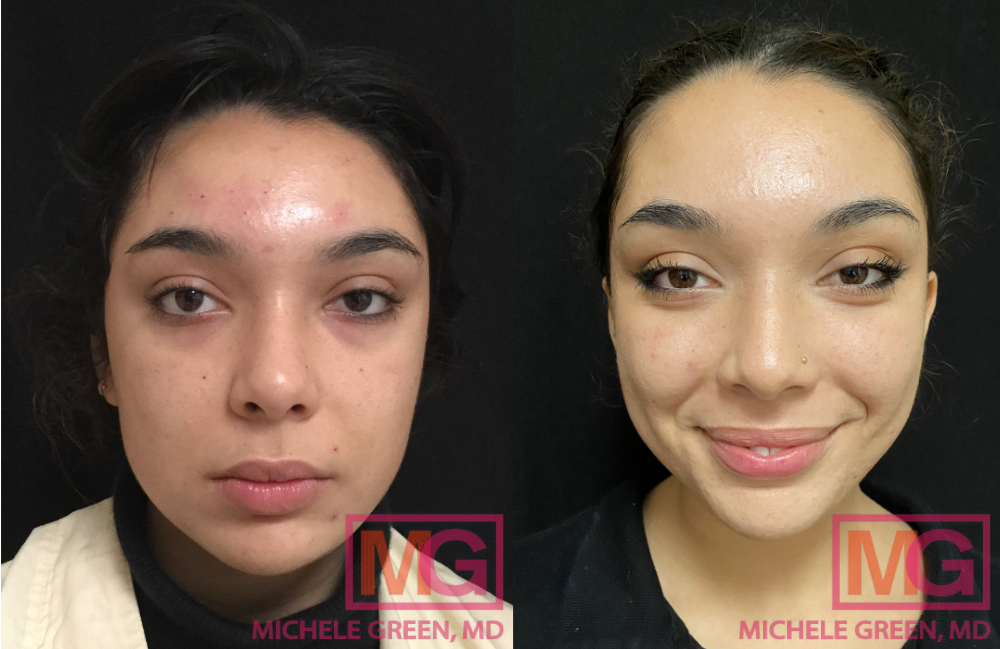
Acne Treatment before and after – 6 months
At what age is hormonal acne worse?
Hormonal acne specifically refers to acne that occurs in adulthood due to fluctuating hormones. Many adults, particularly women aged 20 to 40, experience this type of acne. These hormonal fluctuations can arise from several factors, including the menstrual cycle, pregnancy, and the side effects of medications. Therefore, while many individuals face the most severe acne during their teenage years, others may not experience significant flare-ups until adulthood.
When does hormonal acne stop?
Untreated adult Untreated adult hormonal acne can persist for years or even a lifetime. There is no definitive timeline for when adult acne disappears, as individuals can start experiencing it at any age from their 20s to 50s. Untreated breakouts, especially cysts, can inflict permanent damage to the underlying skin tissue, leading to acne scars that are often more difficult to treat than the initial breakouts. Therefore, individuals who develop adult hormonal acne should begin treatment immediately to prevent scarring. The best course of action is to schedule a consultation with an experienced, board-certified dermatologist, such as Dr. Michele Green in New York City. Dr. Green will evaluate your skin condition, gather a thorough medical and family history, and review any previous acne treatments you’ve undergone. Blood tests may be conducted to assess any irregular hormone levels. Dr. Green will then develop a personalized acne treatment plan aimed at clearing your hormonal acne and achieving smooth, acne-free skin.
How do you fix hormonal acne?
Although hormonal acne is a common type of breakout among adults, its causes can vary from person to person. Each individual requires a personalized treatment plan to manage their acne long-term. The first step in addressing hormonal acne is to consult with a board-certified dermatologist, such as Dr. Michele Green. With a customized treatment plan developed by Dr. Green, hormonal acne can become a thing of the past. Hormonal acne can be effectively managed with the right combination of in-office treatments, topical creams, oral medications, and specially formulated skincare products. Dr. Green can identify the underlying factors contributing to your acne breakouts and recommend appropriate treatment options to achieve and maintain healthy, smooth, and clear skin.
Frequently Asked Questions (FAQs):
Why does hormonal acne appear on the jawline and chin?
Hormonal acne can occur anywhere on the body where sebaceous glands are present, but it is most commonly found on the lower face, including the chin, jawline, and cheeks. The jawline and chin have higher concentrations of sebaceous glands than other areas, leading to increased acne development in these regions. In younger individuals experiencing hormonal acne due to puberty, the T-zone (forehead, nose, and chin) is typically the most affected area. Although less common, hormonal acne can also appear on the chest and back. This type of acne can result in various lesions, including small pimples, cysts, blackheads, whiteheads, nodules, papules, and pustules. Inflammatory lesions like cysts and pustules may be deep, red, and painful, often resulting in acne scars that are more difficult to treat than the acne itself.
Why am I getting hormonal acne all of a sudden?
A common question in Dr. Green’s boutique A common question in Dr. Green’s boutique dermatology office is, “Why did I develop hormonal acne?” Anyone can develop hormonal acne; however, women are more likely to experience it than men. Hormonal acne occurs when hormonal fluctuations increase the oil production by your skin. This oil interacts with bacteria in the pores around your hair follicles, resulting in acne. Hormonal fluctuations can happen for several reasons, but they often occur during puberty, pregnancy, and the menstrual cycle. If you begin to develop hormonal acne, don’t stress; Dr. Green is here to help. She can identify the underlying factors contributing to your acne breakouts and provide appropriate treatment options to achieve clear skin.
How do you stop a hormonal pimple from forming?
Hormonal Hormonal pimples can sometimes be inevitable. However, treatments are available to reduce their frequency and accelerate recovery. Medications like Spironolactone and birth control pills may help regulate hormone fluctuations, which decreases oil production caused by androgen hormones. Reduced oil production often results in fewer pimples. When a pimple has already formed, targeted topical medications such as antibiotics or benzoyl peroxide can help diminish acne-causing bacteria and inflammation. To determine which treatment option is best for your acne, it is advisable to consult an experienced, board-certified dermatologist, such as Dr. Michele Green in New York City.
Which vitamins work for hormonal acne?
Some patients choose to utilize the benefits of oral zinc supplements to combat stubborn acne breakouts. Zinc is a natural anti-inflammatory agent that can help reduce the skin irritation associated with breakouts and regulate oil production. Vitamins A, B, C, and E can also assist in treating acne by maintaining normal hormone levels, reducing inflammation, and acting as antioxidants to support overall skin health. While ensuring adequate levels of vitamins and minerals is crucial for general health, vitamins alone cannot effectively treat hormonal acne breakouts. It is advisable to consult with a board-certified dermatologist, such as Dr. Green, to discuss the treatment options available for managing your hormonal acne.
Will doxycycline treat hormonal acne?
Doxycycline is an oral antibiotic that treats acne by inhibiting the growth of bacteria that cause acne and reducing inflammation. While doxycycline and other tetracycline antibiotics are often the first choice for treating acne, Doxycycline is an oral antibiotic that treats acne by inhibiting the growth of bacteria responsible for acne and reducing inflammation. While doxycycline and other tetracycline antibiotics are often the first choice for treating breakouts, adult hormonal acne in women does not always resolve with doxycycline alone. In fact, adult hormonal acne often does not respond well to oral antibiotics, as the underlying cause is hormonal fluctuations. Therefore, treatments targeting the root cause of hormonal acne, specifically the androgen hormones, frequently provide greater benefits to patients. Many individuals with hormonal acne find relief from other treatment options, such as oral contraceptives or Spironolactone. Most patients rely on a combination of hormonal acne treatments to achieve and maintain clear skin. Dr. Green will collaborate with you to develop an acne treatment plan that best suits your needs.
Will birth control help hormonal acne?
Birth control pills can help manage hormonal acne by regulating androgen levels. Brands such as Ortho Tri-Cyclen, Estrostep, and YAZ have been approved by the Food and Drug Administration (FDA) to treat this condition. Effective oral contraceptives for hormonal acne should contain a combination of progesterone and estrogen to reduce the body’s androgen levels. Elevated levels of androgen hormones increase the production of sebum, worsening acne. For healthy women interested in managing their hormonal acne with oral birth control, the first step is to consult a board-certified dermatologist, such as Dr. Green in NYC.
Will Accutane work for hormonal acne?
Yes! Accutane, also known as Yes! Accutane, also known as isotretinoin, is an effective treatment for hormonal acne. This vitamin A derivative combats acne by reducing oil production, shrinking the size of sebaceous glands, and limiting the growth of bacteria that cause acne. Accutane typically involves a 20-week course of medication, but some patients may require a longer duration depending on their response. The most common side effects associated with this oral vitamin A derivative include dry skin, lips, and eyes. Patients must take specific precautions while using Accutane, as the medication can increase photosensitivity and elevate liver enzymes. Avoiding alcohol consumption and limiting dietary fat intake are recommended for those on Accutane. Isotretinoin is contraindicated for pregnant patients and those trying to conceive, as it can raise the risk of birth defects. Monthly visits and blood tests are required to obtain an Accutane prescription from a board-certified dermatologist.
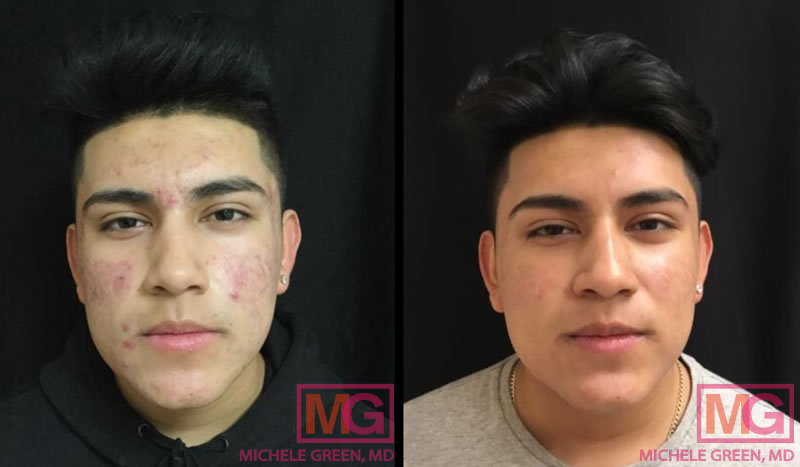
What is the best pill for hormonal acne?
The best pill to treat The best pill to treat hormonal acne varies from person to person. Some individuals may see improvements in acne and oily skin with Accutane, while others may benefit from Spironolactone. Those looking for the optimal pill for their hormonal acne should consult an experienced, board-certified dermatologist, such as Dr. Michele Green in New York City. During your consultation with Dr. Green, she will gather a complete medical history and conduct any necessary blood work to determine the best treatment plan for you, including the recommended oral medications.
Will tretinoin help hormonal acne?
Also known as Retin-A, tretinoin can enhance the appearance of Also known as Retin-A, tretinoin can improve the appearance of hormonal acne. It increases skin cell turnover, which helps exfoliate dead skin cells that can clog pores and lead to acne. Faster cell turnover opens your pores, releasing trapped bacteria or irritants that contribute to acne. Retinoids like tretinoin also help your skin regulate its sebum production, which aids in preventing future breakouts. Differin gel, or adapalene, is a prescription-strength retinoid similar to tretinoin that prevents acne breakouts while evening out skin tone and texture. Tretinoin is available only with a prescription from a healthcare provider. When consulting with Dr. Green about your hormonal acne, she may recommend incorporating tretinoin or another retinol to help manage your condition.
Will retinol help hormonal acne?
Retinols are over-the-counter vitamin A derivatives better suited for patients with sensitive skin, as retinoids can be too irritating for some individuals. For those with sensitive skin or suffering from rosacea, topical retinoids may not be the best solution since they can cause dryness, redness, and flaking when first introduced. Retinols are less irritating and offer a great option for decreasing acne. Similar to retinoids, retinol encourages cell turnover, removing dead skin cells and debris that can clog pores and lead to acne. Additionally, retinols can make the skin more sun-sensitive, so wearing proper sun protection is imperative to safeguard the skin.
Will Differin help with hormonal acne?
Differin gel is an over-the-counter vitamin A derivative that helps remove dead skin cells, which prevents sebum and other impurities from clogging pores. It contains the active ingredient adapalene, which is more potent than other over-the-counter retinol products. Along with reducing active breakouts, regular use of Differin can help prevent new pimples from forming and enhance the appearance of skin tone, texture, and overall radiance. Similar to tretinoin, Differin may cause irritation and is not recommended for patients with sensitive skin or rosacea. Moreover, Differin can increase sun sensitivity, so it is crucial to follow proper sun protection guidelines and apply sunscreen with an SPF of 50 or higher when using Differin gel.
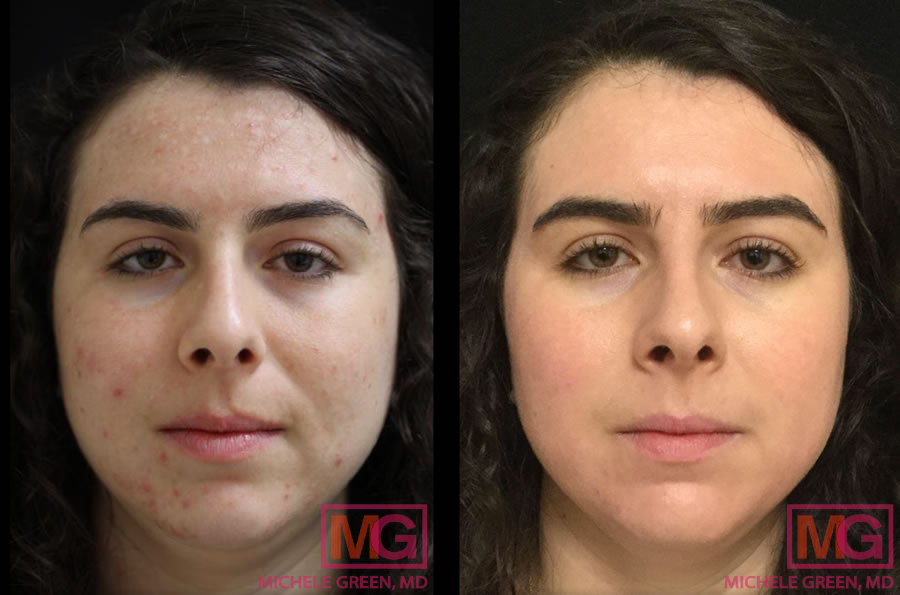
Will salicylic acid help hormonal acne?
Salicylic acid is a chemical exfoliant known as a beta-hydroxy acid(BHA). BHAs are oil-soluble and work on both the surface of the skin and within the pores. Salicylic acid softens the oil, debris, and dead skin cells that clog the pores, allowing the trapped materials to escape and minimizing acne. It is an effective topical treatment that can both treat and prevent acne lesions, including blackheads, whiteheads, papules, and pustules. Many products, such as the Pore Minimizing Cleanser and Retexturizing Pads from MGSKINLABs, harness the acne-fighting power of salicylic acid to help patients achieve clear, smooth skin.
Will benzoyl peroxide help hormonal acne?
Yes! Benzoyl peroxide can effectively treat hormonal acne by targeting the bacteria that thrive in clogged pores. By killing these bacteria and inhibiting their growth, benzoyl peroxide reduces the risk of future breakouts. Additionally, its anti-inflammatory properties help calm the redness and swelling associated with active acne lesions. It’s important to note that while benzoyl peroxide can be beneficial, it may cause dryness or irritation, particularly for those with sensitive skin. Moreover, combining benzoyl peroxide with other treatments, such as hormonal therapies or topical retinoids, may enhance results for hormonal acne. Always consult with a dermatologist to determine the best approach for your specific skin type and concerns.
What cleanser is best for hormonal acne?
The best cleanser for hormonal acne will gently remove excess oil, dirt, and debris without drying out the skin. Exfoliating ingredients like salicylic acid penetrate the pores to break up and eliminate impurities, effectively minimizing hormonal acne. Other components, such as benzoyl peroxide, kill acne-causing bacteria and reduce inflammation to treat and prevent breakouts. To achieve the most effective results, patients should use the cleanser twice daily to unclog pores and remove debris from their faces.
Why won’t hormonal acne go away?
Hormonal acne often doesn’t clear up because it is driven by internal imbalances, particularly fluctuations in hormones such as androgens, which increase oil production and clog pores. These imbalances can persist due to factors like menstrual cycles, stress, polycystic ovary syndrome (PCOS), or certain medications. Unlike surface-level acne, hormonal acne tends to be deeper, more persistent, and resistant to typical over-the-counter treatments. When hormonal acne doesn’t improve, it indicates that the treatments are likely ineffective in targeting the specific causal factors behind the breakouts. If you struggle with persistent hormonal acne or recurring breakouts, consult Dr. Green in New York City, who will work with you to identify the underlying factors contributing to your hormonal breakouts and recommend the acne treatment options best suited to your needs. After starting hormonal acne treatment, it may take up to six weeks to see improvements in your skin condition. This holds true for both topical treatments and oral medications, as regulating hormones or eliminating acne-causing bacteria takes time. The sooner you consult with an expert like Dr. Green, the sooner you can achieve a healthier, smoother, and clearer complexion.
Why do dairy and eggs cause hormonal acne?
Some patients in Dr. Green’s private dermatology office wonder, “Are eggs bad for hormonal acne?” The answer is maybe. While eating eggs does not cause acne for everyone, they contain a wealth of beneficial nutrients and hormones. These hormones can lead to acne when present in excess. Though not everyone experiences acne flares from eggs, patients should be mindful of how their diet affects their skin. Similarly, dairy products have been scrutinized for their potential negative impact on hormonal acne. Research indicates that dairy can worsen acne in some individuals. Cow’s milk contains proteins like whey and casein. When the body metabolizes these proteins, it produces a hormone known as IGF-1, which can trigger breakouts. To determine the underlying cause of your acne, it’s best to consult with a board-certified dermatologist like Dr. Michele Green. Dr. Green will conduct necessary tests to identify the cause of your acne before developing a personalized treatment plan that helps you achieve a lasting clear complexion.
How can I clear hormonal acne?
Hormonal acne can be challenging to manage on your own. To address it, many patients consult a board-certified dermatologist like Dr. Green, who can assess hormonal acne during a physical examination. Additionally, other contributing factors will be evaluated, including your skincare routine, family history of acne, lifestyle habits, and any underlying health conditions. Dr. Green may also suggest blood tests to check for imbalances in specific hormone levels that could be causing the breakouts. Following this, Dr. Green will discuss the best treatment options tailored to your hormonal acne, helping you achieve and maintain the clear skin you desire.
How do I get started with hormonal acne treatment today?
While people often associate acne with teenagers, many adults also experience persistent hormonal breakouts that can harm self-esteem and confidence. Hormonal acne may be linked to changes such as menstruation, menopause, the onset or discontinuation of birth control, and pregnancy. Although it can be particularly challenging to treat, Dr. Green provides a range of oral medications, topical creams, in-office treatments, and targeted skincare products to manage hormonal acne breakouts for healthy, radiant, and clear skin. With numerous treatment options available, it can be difficult to determine which ones are right for you, making it essential to schedule an appointment with expert dermatologist Dr. Michele Green as the initial step in addressing hormonal acne.
Dr. Michele Green, based in New York City, is an internationally acclaimed, board-certified Dr. Michele Green, located in New York City, is an internationally acclaimed, board-certified dermatologist with over 25 years of experience offering discerning clients worldwide the finest non-invasive treatment options available, including prescription medications, in-office procedures, and focused skincare products for acne breakouts and scars. Dr. Green is consistently honored as one of New York’s top dermatologists by Castle Connolly, New York Magazine, Super Doctors, and The New York Times due to her dedication to her patients and her expertise. Dr. Green provides personalized solutions that help you look and feel like the best version of yourself. To schedule a consultation with Dr. Green and discover the ideal hormonal acne treatment plan for you, reach out to us online or call our NYC office at 212-535-3088.
 212-535-3088
212-535-3088 